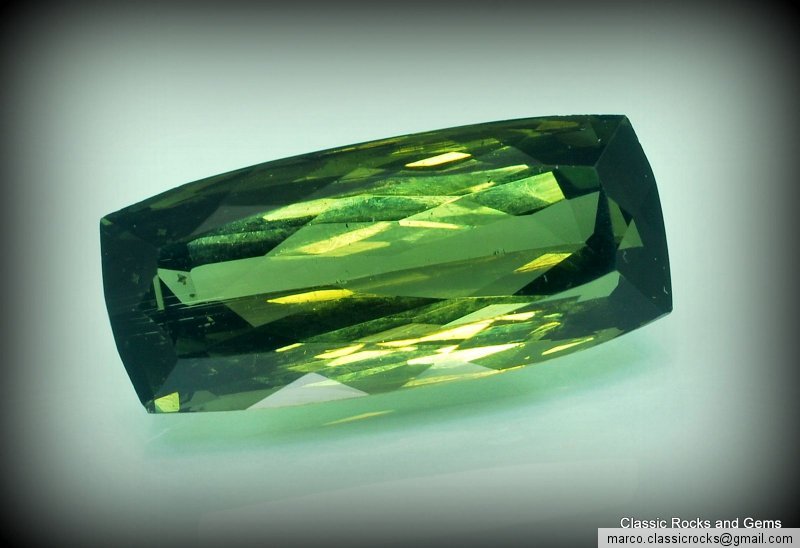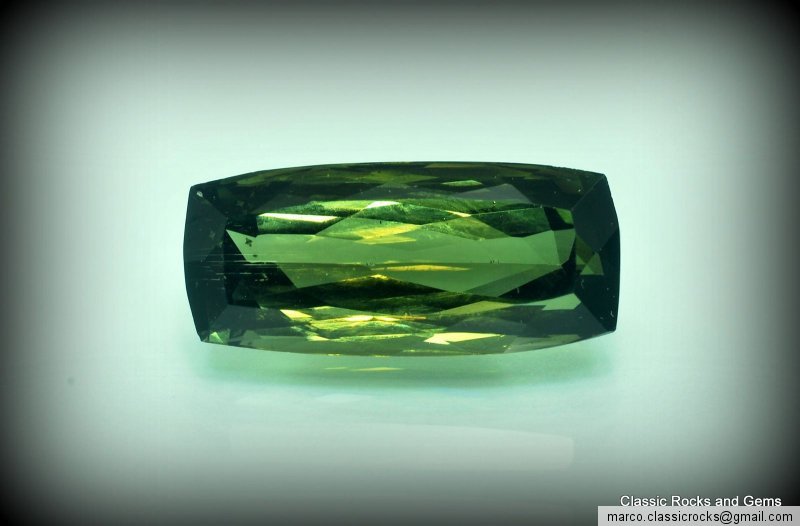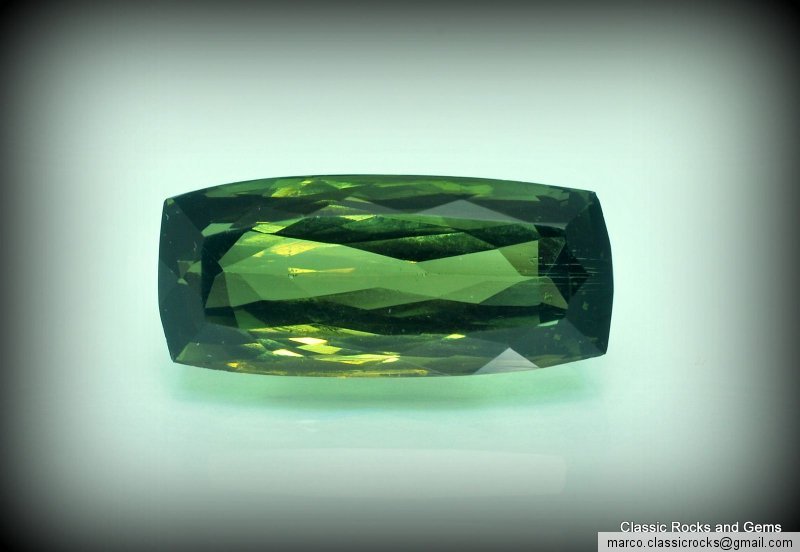


| Tourmaline | |
|---|---|
 Schorl Tourmaline | |
| General | |
| Category | Cyclosilicate |
| Formula (repeating unit) | (Ca,K,Na,[])(Al,Fe,Li,Mg,Mn)3(Al,Cr, Fe,V)6 (BO3)3(Si,Al,B)6O18(OH,F)4 [1][2] |
| Identification | |
| Color | Most commonly black, but can range from brown, violet, green, pink, or in a dual-colored pink and green. |
| Crystal habit | Parallel and elongated. Acicular prisms, sometimes radiating. Massive. Scattered grains (in granite). |
| Crystal system | Trigonal |
| Cleavage | Indistinct |
| Fracture | Uneven, small conchoidal, brittle |
| Mohs scalehardness | 7–7.5 |
| Luster | Vitreous, sometimes resinous |
| Streak | White |
| Specific gravity | 3.06 (+.20 -.06)[1] |
| Density | 2.82–3.32 |
| Polish luster | Vitreous[1] |
| Optical properties | Double refractive, uniaxial negative[1] |
| Refractive index | nω=1.635–1.675, nε=1.610–1.650 |
| Birefringence | -0.018 to -0.040; typically about .020 but in dark stones it may reach .040[1] |
| Pleochroism | typically moderate to strong[1] Red Tourmaline: Definite; dark red,light red Green Tourmaline: Strong; dark green, yellow-green Brown Tourmaline: Definite; dark brown, light brown Blue Tourmaline: Strong; dark blue, light blue |
| Dispersion | .017[1] |
| Ultravioletfluorescence | pink stones—inert to very weak red to violet in long and short wave[1] |
| Absorption spectra | a strong narrow band at 498 nm, and almost complete absorption of red down to 640nm in blue and green stones; red and pink stones show lines at 458 and 451nm as well as a broad band in the green spectrum[1] |
Tourmaline (tur-mah-Leen) is a crystal boron silicate mineral compounded with elements such as aluminium, iron, magnesium, sodium, lithium, or potassium. Tourmaline is classified as a semi-precious stone and thegemstone comes in a wide variety of colors. The name comes from the Sinhalese word "Thuramali" (තුරමලි) or "Thoramalli" (තෝරමල්ලි), which applied to different gemstones found in Sri Lanka.
Contents[hide] |
History[edit]
Brightly colored Sri Lankan gem tourmalines were brought to Europe in great quantities by the Dutch East India Company to satisfy a demand for curiosities and gems. At the time it was not realised that schorl and tourmaline were the same mineral.
Tourmaline species and varieties[edit]
Commonly encountered species and varieties
- Schorl species:
- Bluish or brownish black to Black—schorl
- Dravite species: from the Drave district of Carinthia
- Dark yellow to brownish black—dravite
- Elbaite species: named after the island of Elba, Italy
Schorl[edit]
The most common species of tourmaline is schorl. It may account for 95% or more of all tourmaline in nature. The early history of the mineral schorl shows that the name "schorl" was in use prior to 1400 because a village known today as Zschorlau (in Saxony, Germany) was then named "Schorl" (or minor variants of this name). This village had a nearby tin mine where, in addition to cassiterite, black tourmaline was found. The first description of schorl with the name "schürl" and its occurrence (various tin mines in the Saxony Ore Mountains) was written by Johannes Mathesius (1504–1565) in 1562 under the title "Sarepta oder Bergpostill".[3] Up to about 1600, additional names used in the German language were "Schurel", "Schörle", and "Schurl". Beginning in the 18th century, the name Schörl was mainly used in the German-speaking area. In English, the namesshorl and shirl were used in the 18th century. In the 19th century the names common schorl, schörl, schorl andiron tourmaline were the English words used for this mineral.[3] The word tourmaline has two etymologies, both from the Sinhalese word turamali, meaning "stone attracting ash" (a reference to its pyroelectric properties) or according to other sources "mixed gemstones".
Dravite[edit]
The name dravite was used for the first time by Gustav Tschermak(1836–1927), Professor of Mineralogy and Petrography at the University of Vienna, in his book Lehrbuch der Mineralogie (published in 1884) for magnesium-rich (and sodium-rich) tourmaline from the village Unterdrauburg,Drava river area, Carinthia, Austro-Hungarian Empire. Today this tourmaline locality (type locality for dravite) at the village Dravograd (near Dobrova pri Dravogradu), is a part of the Republic of Slovenia.[4] Tschermak gave this tourmaline the name dravite, for the Drava river area, which is the district along the Drava River (in German: Drau, inLatin: Drave) in Austria and Slovenia. The chemical composition which was given by Tschermak in 1884 for this dravite approximately corresponds to the formula NaMg3(Al,Mg)6B3Si6O27(OH), which is in good agreement (except for the OH content) with the endmember formula of dravite as known today.[4]
Elbaite[edit]
A lithium-tourmaline (elbaite) was one of three pegmatitic minerals from Utö, Sweden, in which the new alkali element lithium (Li) was determined in 1818 byJohan August Arfwedson for the first time.[5] Elba Island, Italy, was one of the first localities where colored and colorless Li-tourmalines were extensively chemically analysed. In 1850 Karl Friedrich August Rammelsberg described fluorine (F) in tourmaline for the first time. In 1870 he proved that all varieties of tourmaline contain chemically bound water. In 1889 Scharitzer proposed the substitution of (OH) by F in red Li-tourmaline from Sušice, Czech Republic. In 1914 Vladimir Vernadsky proposed the name Elbait for lithium-, sodium-, and aluminum-rich tourmaline from Elba Island, Italy, with the simplified formula (Li,Na)HAl6B2Si4O21.[5] Most likely the type material for elbaite was found at Fonte del Prete, San Piero in Campo, Campo nell'Elba, Elba Island, Province of Livorno, Tuscany, Italy.[5] In 1933 Winchell published an updated formula for elbaite, H8Na2Li3Al3B6Al12Si12O62, which is commonly used to date written as Na(Li1.5Al1.5)Al6(BO3)3[Si6O18](OH)3(OH).[5] The first crystal structure determination of a Li-rich tourmaline was published in 1972 by Donnay and Barton, performed on a pink elbaite from San Diego County, California, United States.
Chemical composition of the tourmaline group[edit]
The tourmaline mineral group is chemically one of the most complicated groups of silicate minerals. Its composition varies widely because of isomorphous replacement (solid solution), and its general formula can be written as
XY3Z6(T6O18)(BO3)3V3W,
where:[6]
X = Ca, Na, K, ៛ = vacancy
Y = Li, Mg, Fe2+, Mn2+, Zn, Al, Cr3+, V3+, Fe3+, Ti4+, vacancy
Z = Mg, Al, Fe3+, Cr3+, V3+
B = B, vacancy
W = OH, F, O
| Chromium-dravite | NaMg3Cr6Si6O18(BO3)3(OH)3OH |
| Chromo-alumino-povondraite | NaCr3(Al4Mg2)Si6O18(BO3)3(OH)3O |
| Darrellhenryite | NaLiAl2Al6Si6O18(BO3)3(OH)3O |
| Dravite | NaMg3Al6Si6O18(BO3)3(OH)3OH |
| Elbaite | Na(Li1.5,Al1.5)Al6Si6O18(BO3)3(OH)3OH |
| Feruvite | CaFe2+3(MgAl5)Si6O18(BO3)3(OH)3OH |
| Fluor-buergerite | NaFe3+3Al6Si6O18(BO3)3O3F |
| Fluor-dravite | NaMg3Al6Si6O18(BO3)3(OH)3F |
| Fluor-elbaite | Na(Li1.5,Al1.5)Al6Si6O18(BO3)3(OH)3F |
| Fluor-liddicoatite | Ca(Li2Al)Al6Si6O18(BO3)3(OH)3F |
| Fluor-schorl | NaFe2+3Al6Si6O18(BO3)3(OH)3F |
| Fluor-tsilaisite | NaMn2+3Al6Si6O18(BO3)3(OH)3F |
| Fluor-uvite | CaMg3(Al5Mg)Si6O18(BO3)3(OH)3F |
| Foitite | ៛(Fe2+2Al)Al6Si6O18(BO3)3(OH)3OH |
| Magnesiofoitite | ៛(Mg2Al)Al6Si6O18(BO3)3(OH)3OH |
| Olenite | NaAl3Al6Si6O18(BO3)3O3OH |
| Oxy-chromium-dravite | NaCr3(Mg2Cr4)Si6O18(BO3)3(OH)3O |
| Oxy-dravite | Na(Al2Mg)(Al5Mg)Si6O18(BO3)3(OH)3O |
| Oxy-schorl | Na(Fe2+2Al)Al6Si6O18(BO3)3(OH)3O |
| Oxy-vanadium-dravite | NaV3(V4Mg2)Si6O18(BO3)3(OH)3O |
| Povondraite | NaFe3+3(Fe3+4Mg2)Si6O18(BO3)3(OH)3O |
| Rossmanite | ៛(LiAl2)Al6Si6O18(BO3)3(OH)3OH |
| Schorl | NaFe2+3Al6Si6O18(BO3)3(OH)3OH |
| Tsilaisite | NaMn2+3Al6Si6O18(BO3)3(OH)3OH |
| Uvite | CaMg3(Al5Mg)Si6O18(BO3)3(OH)3OH |
| Vanadio-oxy-chromium-dravite | NaV3(Cr4Mg2)Si6O18(BO3)3(OH)3O |
| Vanadio-oxy-dravite | NaV3(Al4Mg2)Si6O18(BO3)3(OH)3O |
A revised nomenclature for the tourmaline group was published in 2011.[7][8][9]
Physical properties[edit]
Crystal structure[edit]
Tourmaline belongs to the trigonal crystal system and occurs as long, slender to thick prismatic and columnarcrystals that are usually triangular in cross-section. The style of termination at the ends of crystals is asymmetrical, called hemimorphism. Small slender prismatic crystals are common in a fine-grained granite called aplite, often forming radial daisy-like patterns. Tourmaline is distinguished by its three-sided prisms; no other common mineral has three sides. Prisms faces often have heavy vertical striations that produce a rounded triangular effect. Tourmaline is rarely perfectly euhedral. An exception was the fine dravite tourmalines of Yinnietharra, in western Australia. The deposit was discovered in the 1970s, but is now exhausted. All hemimorphic crystals are piezoelectric, and are oftenpyroelectric as well.
Color[edit]
Tourmaline has a variety of colors. Usually, iron-rich tourmalines are black to bluish-black to deep brown, while magnesium-rich varieties are brown to yellow, and lithium-rich tourmalines are almost any color: blue, green, red, yellow, pink, etc. Rarely, it is colorless. Bi-colored and multicolored crystals are common, reflecting variations of fluid chemistry during crystallization. Crystals may be green at one end and pink at the other, or green on the outside and pink inside; this type is called watermelon tourmaline. Some forms of tourmaline are dichroic, in that they change color when viewed from different directions.
The pink color of tourmalines from many fields is the result of prolonged natural irradiation. During their growth, these tourmaline crystals incorporated Mn2+ and were initially very pale. Due to natural gamma ray exposure fromradioactive decay of 40K in their granitic environment, gradual formation of Mn3+ ions occurs, which is responsible for the deepening of the pink to red color.[10]
Treatments[edit]
Some tourmaline gems, especially pink to red colored stones, are altered by irradiation to improve their color. Irradiation is almost impossible to detect in tourmalines, and does not, currently, impact the value. Heat treatment is also used to enhance tourmaline. Heavily-included tourmalines, such as rubellite and Brazilian paraiba, are sometimes clarity-enhanced. A clarity-enhanced tourmaline (especially paraiba) is worth much less than a non-treated gem.[11]
Geology[edit]
Tourmaline is found in granite and granite pegmatites and in metamorphic rocks such as schist and marble. Schorl and lithium-rich tourmalines are usually found in granite and granite pegmatite. Magnesium-rich tourmalines, dravites, are generally restricted to schists and marble. Tourmaline is a durable mineral and can be found in minor amounts as grains in sandstone and conglomerate, and is part of the ZTR index for highly-weathered sediments.
Tourmaline localities[edit]
Gem and specimen tourmaline is mined chiefly in Brazil and Africa. Some placer material suitable for gem use comes from Sri Lanka. In addition to Brazil, tourmaline is mined in Tanzania, Nigeria, Kenya, Madagascar,Mozambique, Namibia, Afghanistan, Pakistan, Sri Lanka, and Malawi.[12]
United States[edit]
Some fine gems and specimen material has been produced in the United States, with the first discoveries in 1822, in the state of Maine. California became a large producer of tourmaline in the early 1900s. The Maine deposits tend to produce crystals in raspberry pink-red as well as minty greens. The California deposits are known for bright pinks, as well as bicolors. During the early 1900s, Maine and California were the world's largest producers of gem tourmalines. The Empress Dowager Tz'u Hsi of China loved pink tourmaline and bought large quantities for gemstones and carvings from the then new Himalaya Mine, located in San Diego County, California.[13] It is not clear when the first tourmaline was found in California. Native Americans have used pink and green tourmaline as funeral gifts for centuries. The first documented case was in 1890 when Charles Russel Orcutt found pink tourmaline at what later became the Stewart Mine at Pala, San Diego.[14]
Brazil[edit]
Almost every color of tourmaline can be found in Brazil, especially in the Brazilian states of Minas Gerais and Bahia. In 1989, miners discovered a unique and brightly colored variety of tourmaline in the state of Paraíba.[citation needed] The new type of tourmaline, which soon became known as paraiba tourmaline, came in blue and green. Brazilian paraiba tourmaline is usually contains abundant inclusions. Much of the paraiba tourmaline from Brazil actually comes from the neighboring state of Rio Grande do Norte. Material from Rio Grande do Norte is often somewhat less intense in color, but many fine gems are found there. It was determined that the element copper was important in the coloration of the stone.[15]
World's largest[edit]
A large cut tourmaline from Paraiba, measuring 36.44 x 33.75 x 21.85 mm (1.43 x 1.33 x 0.86 in) and weighing 191.87 carats, was included in the Guinness World Records.[16] The large natural gem, owned by Billionaire Business Enterprises,[16] is a bluish-green in color. The flawless oval shaped cut stone was presented in Montreal, Quebec, Canada on 14 October 2009.[17]
Africa[edit]
In the late 1990s, copper-containing tourmaline was found in Nigeria. The material was generally paler and less saturated than the Brazilian materials, although the material generally was much less included. A more recent African discovery from Mozambique has also produced beautiful tourmaline colored by copper, similar to the Brazilian paraiba. While its colors are somewhat less bright than top Brazilian material, Mozambique paraiba is often less included and has been found in larger sizes. The Mozambique paraiba material usually is more intensely colored than the Nigerian. There is a significant overlap in color and clarity with Mozambique paraiba and Brazilian paraiba, especially with the material from Rio Grande do Norte. While less expensive than top quality Brazilian paraiba, some Mozambique material sells for well over $5,000 per carat, which still is extremely high compared to other tourmalines.
Another highly valuable variety is chrome tourmaline, a rare type of dravite tourmaline from Tanzania. Chrome tourmaline is a rich green color due to the presence of chromium atoms in the crystal; chromium also produces the green color of emeralds. Of the standard elbaite colors, blue indicolite gems are typically the most valuable,[18]followed by green verdelite and pink to red rubellite.[citation needed] There are also yellow tourmalines, sometimes known as canary tourmaline. Zambia is rich in both red and yellow tourmaline, which are relatively inexpensive in that country. Ironically the rarest variety, colorless achroite, is not appreciated and is the least expensive of the transparent tourmalines.
Afghanistan[edit]
Extra fine indicolite (blue tourmaline) and verdelite (green tourmaline) are found in the Nuristan region (Ghazi Abad district) and Pech Valley (Pech and Chapa Dara districts) of Kunar province. Gem-quality tourmalines are faceted (cut) from 0.50–10 gram sizes and have unusually high clarity and intense shades of color.
Notes[edit]
- ^ a b c d e f g h i Gemological Institute of America, GIA Gem Reference Guide 1995, ISBN 0-87311-019-6
- ^ Mindat tourmaline group Accessed September 12, 2005. This website details specifically and clearly how the complicated chemical formula is structured.
- ^ a b Ertl, 2006.
- ^ a b Ertl, 2007.
- ^ a b c d Ertl, 2008.
- ^ Hawthorne, F.C. & Henry, D.J. (1999). "Classification of the minerals of the tourmaline group". European Journal of Mineralogy, 11, pp. 201–215.
- ^ Darrell J. Henry, Milan Novák, Frank C. Hawthorne, Andreas Ertl, Barbara L. Dutrow, Pavel Uher, and Federico Pezzotta (2011). "Nomenclature of the tourmaline-supergroup minerals". American Mineralogist 96: 895–913. doi:10.2138/am.2011.3636.
- ^ Erratum: American Mineralogist (2013), Volume 98, page 524.
- ^ Frank C. Hawthorne and Dona M. Dirlam. "Tourmaline: Tourmaline the Indicator Mineral: From Atomic Arrangement to Viking Navigation." Elements, October 2011, v. 7, p. (5): 307-312, doi:10.2113/gselements.7.5.307.
- ^ Reinitz & Rossman, 1998.
- ^ Kurt Nassau (1984), Gemstone Enhancement: Heat, Irradiation, Impregnation, Dyeing, and Other Treatments, Butterworth Publishers
- ^ Hurlbut and Klien. Manual of Mineralogy (after Dana), 19th Edition, John Wiley and Sons, Publishers
- ^ Fred Rynerson, Exploring and Mining Gems and Gold in the West, Naturegraph Publishers.
- ^ Paul Willard Johnson, "Common Gems of San Diego," Gems and Gemology, Vol. XII, Winter 1968-69, p. 358.
- ^ Rossman et al. 1991.
- ^ a b Guinness World Records Official Website
- ^ Giant jewel breaks record
- ^ Allison Augustyn, Lance Grande (2009). Gems and Gemstones: Timeless Natural Beauty of the Mineral World. University of Chicago Press. p. 152.ISBN 0226305112.
References[edit]
- Ertl, A., Pertlik, F. & Bernhardt, H.-J. (1997) Investigations on olenite with excess boron from the Koralpe, Styria, Austria, Österreichische Akademie der Wissenschaften, Mathematisch-Naturwissenschaftliche Klasse, Abt. I, Anzeiger, 134, pp 3–10. Article Online
- Ertl, A. (2006) About the etymology and the type localities of schorl Mitteilungen der Österreichischen Mineralogischen Gesellschaft, 152, 2006, pp 7–16.Article Online
- Ertl, A. (2007) About the type locality and the nomenclature of dravite Mitteilungen der Österreichischen Mineralogischen Gesellschaft, 153, 2007, pp 265–271. Article Online
- Ertl, A. (2008) About the nomenclature and the type locality of elbaite: A historical review Mitteilungen der Österreichischen Mineralogischen Gesellschaft, 154, 2008, pp 35–44. Article Online
- Reinitz, I.M. & Rossman G.R. (1988) Role of natural radiation in tourmaline coloration. American Mineralogist, 73, pp 822-825. Article Online
- Rossman, G.R., Fritsch E., & Shigley J.E. (1991) Origin of color in cuprian elbaite from São José de Batalha, Paraíba, Brazil. American Mineralogist, 76, pp 1479-1484. Article Online
- Schumann, Walter (2006). Gemstones of the World 3rd Edition. Sterling Publishing, New York; pp 126–127.
Further reading[edit]
- Darrell J. Henry, Milan Novák, Frank C. Hawthorne, Andreas Ertl, Barbara L. Dutrow, Pavel Uher, and Federico Pezzotta (2011). "Nomenclature of the tourmaline-supergroup minerals". American Mineralogist 96: 895–913. doi:10.2138/am.2011.3636.
External links[edit]
| Wikimedia Commons has media related to: Tourmaline |
| Look up tourmaline in Wiktionary, the free dictionary. |
- Tourmaline classification Accessed October 8, 2011
- Mindat tourmaline group Accessed October 8, 2011
- ICA's tourmaline page International Colored Stone Association on tourmaline
- Farlang historical tourmaline references US localities, antique references,
- Webmineral elbaite page, crystallographic and mineral information on elbaite
- Tourmaline Characteristics and Geological data
| ||||||||||||||||||||||||||||||||||||||||||







